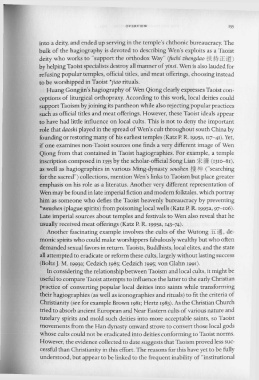Page 195 - The Encyclopedia of Taoism v1_A-L
P. 195
OVERVIEW 155
into a deity; and ended up serving in the temple's chthonic bureaucracy. The
bulk of the hagiography is devoted to describing Wen's exploits as a Taoist
deity who works to "support the orthodox Way" (fitchi zhengdao 1}( fir lE J1!)
by helping Taoist specialists destroy all manner of yinsi. Wen is also lauded for
refusing popular temples, official titles, and meat offerings, choosing instead
to be worshipped in Taoist *jiao rituals.
Huang Gongjin's hagiography of Wen Qiong clearly expresses Taoist con-
ceptions of liturgical orthopraxy. According to this work, local deities could
support Taoism by joining its pantheon while also rejecting popular practices
such as official titles and meat offerings. However, these Taoist ideals appear
to have had little influence on local cults. This is not to deny the important
role that daoshi played in the spread of Wen's cult throughout south China by
founding or restoring many of his earliest temples (Katz P. R. 1995a, II7- 41). Yet,
if one examines non-Taoist sources one finds a very different image of Wen
Qiong from that contained in Taoist hagiographies. For example, a temple
inscription composed in 1355 by the scholar-official Song Lian * 7J (1310-81),
as well as hagiographies in various Ming-dynasty sous hen fl;f$ ("searching
for the sacred") collections, mention Wen's links to Taoism but place greater
emphasis on his role as a literatus. Another very different representation of
Wen may be found in late imperial fiction and modern folktales, which portray
him a someone who defies the Taoist heavenly bureaucracy by preventing
*wenshen (plague spirits) from poisoning local wells (Katz P. R. 1995a, 97- 106).
Late imperial sources about temples and festivals to Wen also reveal that he
usually received meat offerings (Katz P. R. 1995a, 143-74).
Another fascinating example involves the cults of the Wutong liim, de-
monic spirits who could make worshippers fabulously wealthy but who often
demanded sexual favors in return. Taoists, Buddhists, local elites, and the state
all attempted to eradicate or reform these cults, largely without lasting success
(BoltzJ. M. 1993a; Cedzich 1985; Cedzich 1995; von Glahn 1991).
In considering the relationship between Taoism and local cults, it might be
useful to compare Taoist attempts to influence the latter to the early Christian
practice of converting popular local deities into saints while transforming
their hagiographies (as well as iconographies and rituals) to fit the criteria of
Christianity (see for example Brown 1981; Hertz 1983). As the Christian Church
tried to absorb ancient European and Near Eastern cults of various nature and
tutelary spirits and mold such deities into more acceptable saints, so Taoist
movements from the Han dynasty onward strove to convert those local gods
whose cults could not be eradicated into deities conforming to Taoist norms.
However, the evidence collected to date suggests that Taoism proved less suc-
cessful than Christianity in this effort. The reasons for this have yet to be fully
understood, but appear to be linked to the frequent inability of "institutional

